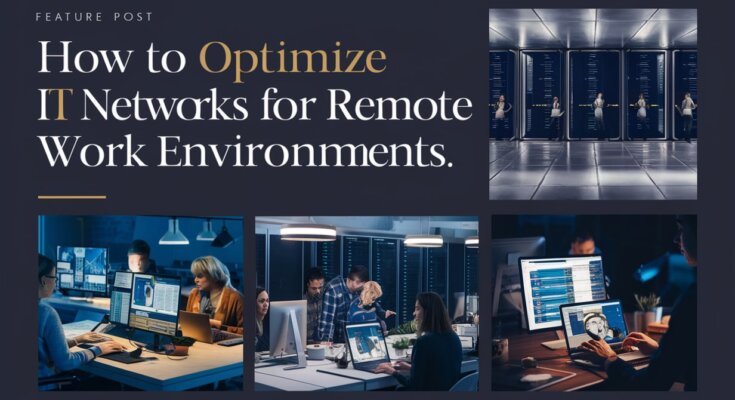If your business is adjusting to more employees working from home, optimizing your IT network is a key step for staying productive. A well-tuned network helps avoid connection issues, boosts security, and supports smoother collaboration.
Here’s a look at how to set up your IT network for a remote work environment.
Table of Contents
The Challenges of Remote Work IT Networks
It’s essential to recognize the unique challenges posed by remote work environments:
- Increased network traffic
- Security vulnerabilities
- Varied device types and operating systems
- Inconsistent internet connections
- Limited IT support accessibility
Addressing these challenges requires a comprehensive approach that combines technology, policy, and user education. Managed IT Services Toronto providers can play a crucial role in helping businesses navigate these complexities and implement effective solutions.
Essential Strategies for IT Network Optimization
Some of the important ones are:
1. Implement a Robust VPN Solution
A Virtual Private Network (VPN) is the backbone of secure remote work. It creates an encrypted tunnel between remote devices and your company’s network, safeguarding data transmission.
Key considerations for VPN implementation:
- Choose a scalable solution that can handle increased user load
- Opt for split-tunneling to reduce unnecessary traffic
- Implement multi-factor authentication for enhanced security
2. Embrace Cloud-Based Services
Cloud services offer flexibility, scalability, and accessibility which are crucial for remote work environments. By moving key applications and data to the cloud, you can:
- Reduce strain on your on-premises infrastructure
- Provide easier access to resources for remote workers
- Improve collaboration and file-sharing capabilities
Popular cloud services for remote work:
| Service Type | Examples |
| File Storage and Sharing | Google Drive, Dropbox, OneDrive |
| Collaboration Tools | Microsoft Teams, Slack, Zoom |
| Project Management | Asana, Trello, Monday.com |
| Cloud-Based Office Suites | Google Workspace, Microsoft 365 |
3. Optimize Bandwidth Usage
With increased network traffic from remote workers, optimizing bandwidth usage is crucial. Consider these strategies:
- Implement Quality of Service (QoS) policies to prioritize critical applications
- Use content delivery networks (CDNs) for frequently accessed resources
- Encourage the use of video compression for online meetings
Read More Article: What Is the Difference Between SD-WAN and Traditional WAN?
4. Enhance Network Security
Remote work environments expand the attack surface for cybercriminals. Strengthen your network security with these measures:
- Deploy next-generation firewalls with advanced threat protection
- Implement endpoint detection and response (EDR) solutions
- Regularly update and patch all systems and applications
Security best practices for remote workers:
- Use strong, unique passwords and a password manager
- Enable multi-factor authentication on all accounts
- Keep personal and work devices separate
- Avoid using public Wi-Fi networks without a VPN
5. Implement Remote Monitoring and Management Tools
Proactive monitoring and management of your IT infrastructure are essential for maintaining optimal performance and security. Managed IT Services providers often utilize advanced Remote Monitoring and Management (RMM) tools to:
- Detect and resolve issues before they impact productivity
- Automate routine maintenance tasks
- Monitor network performance and security in real-time
- Provide valuable insights for capacity planning and optimization
Empowering Remote Workers Through Technology and Training
Optimizing IT networks is not just about technology; it’s also about empowering your remote workforce to use these tools effectively. Consider the following strategies:
1. Provide Comprehensive Training
Offer regular training sessions on:
- Proper use of VPN and security protocols
- Effective utilization of collaboration tools
- Best practices for remote work productivity
- Cybersecurity awareness and safe online behavior
2. Establish Clear IT Policies
Develop and communicate clear policies regarding:
- Acceptable use of company devices and resources
- Data handling and confidentiality
- Personal device usage (BYOD policies)
- Incident reporting procedures
3. Offer Remote IT Support
Ensure that your remote workers have access to timely IT support:
- Implement a user-friendly ticketing system
- Provide remote desktop support capabilities
- Offer self-service resources for common issues
- Consider extending support hours to accommodate different time zones
Integrating Managed IT Services for Remote Work Success
As organizations navigate the complexities of remote work environments, many are turning to Managed IT Services Toronto providers for expert assistance. These professionals bring a wealth of experience and specialized knowledge to the table, helping businesses:
- Design and implement optimized network architectures
- Manage and maintain complex IT infrastructures
- Stay ahead of emerging security threats
- Provide 24/7 monitoring and support
By partnering with a reputable IT service provider, businesses can focus on their core competencies while ensuring their IT networks are robust, secure, and optimized for remote work.
Future-Proofing Your Remote Work IT Infrastructure
As remote work continues to evolve, it’s crucial to build an IT infrastructure that can adapt to future needs. Consider these forward-thinking strategies:
1. Explore Software-Defined Networking (SDN)
SDN offers greater flexibility and control over network resources, making it easier to adapt to changing requirements:
- Simplifies network management and configuration
- Enables more efficient resource allocation
- Improves network performance and security
2. Investigate Edge Computing Solutions
Edge computing can help reduce latency and improve performance for remote workers:
- Brings computing resources closer to end-users
- Reduces strain on central network infrastructure
- Enhances the performance of real-time applications
3. Prepare for 5G Integration
As 5G networks become more widespread, they will offer new possibilities for remote work:
- Faster, more reliable connections for remote workers
- Enhanced support for bandwidth-intensive applications
- New opportunities for augmented and virtual reality collaboration tools
Read More Article: How to Protect Business Networks from DDoS Attacks?
Measuring the Success of Your IT Network Optimization
To ensure your optimization efforts are effective, it’s important to track key performance indicators (KPIs). Consider monitoring the following metrics:
| KPI | Description |
| Network Uptime | Percentage of time the network is operational |
| Average Response Time | Time taken to respond to user requests |
| Bandwidth Utilization | Percentage of available bandwidth being used |
| Security Incident Rate | Number of security incidents over time |
| User Satisfaction | Feedback from remote workers on IT performance |
Regularly reviewing these metrics will help you identify areas for improvement and demonstrate the value of your optimization efforts.
Wrap Up
Optimizing IT networks for remote work environments is an ongoing process that requires dedication, expertise, and a willingness to adapt to changing technologies and work practices. By implementing the strategies outlined in this guide and partnering with experienced Managed IT Services providers, organizations can create robust, secure, and efficient IT infrastructures that support the future of work.




